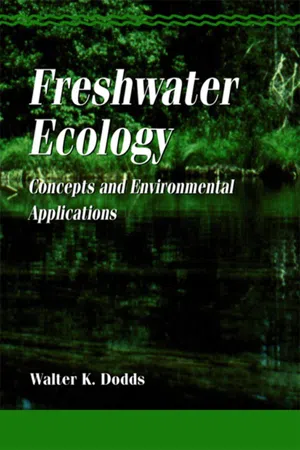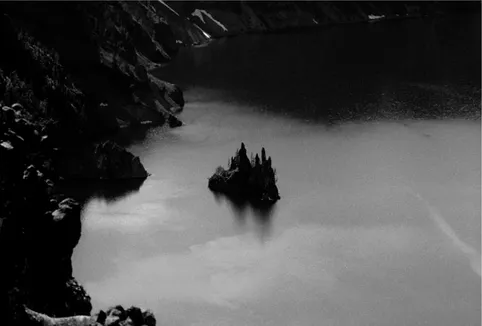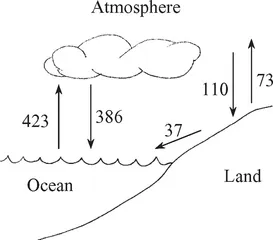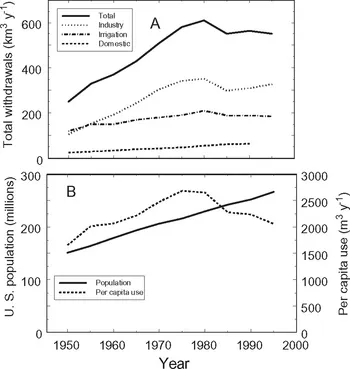
eBook - ePub
Freshwater Ecology
Concepts and Environmental Applications
Walter K. Dodds
This is a test
- 569 Seiten
- English
- ePUB (handyfreundlich)
- Über iOS und Android verfügbar
eBook - ePub
Freshwater Ecology
Concepts and Environmental Applications
Walter K. Dodds
Angaben zum Buch
Buchvorschau
Inhaltsverzeichnis
Quellenangaben
Über dieses Buch
Freshwater Ecology: Concepts and Environmental Applications is a general text covering both basic and applied aspects of freshwater ecology and serves as an introduction to the study of lakes and streams. Issues of spatial and temporal scale, anthropogenic impacts, and application of current ecological concepts are covered along with ideas that are presented in more traditional limnological texts. Chapters on biodiversity, toxic chemicals, extreme and unusual habitats, and fisheries increase the breadth of material covered. The book includes an extensive glossary, questions for thought, worked examples of equations, and real-life problems.
- Broad coverage of groundwaters, streams, wetlands, and lakes
- Features basic scientific concepts and environmental applications throughout
- Includes many figures, sidebars of fascinating applications, and biographies of practicing aquatic ecologists
- Materials are presented to facilitate learning, including an extensive glossary, questions for thought, worked examples of equations, and real life problems
- Written at a level understandable to most undergraduate students, with explanations of complex contemporary concepts in freshwater ecology described to promote understanding
- Featuring small chapters that mainly stand alone, this book can be read in the order most suited to the specific application
Häufig gestellte Fragen
Wie kann ich mein Abo kündigen?
Gehe einfach zum Kontobereich in den Einstellungen und klicke auf „Abo kündigen“ – ganz einfach. Nachdem du gekündigt hast, bleibt deine Mitgliedschaft für den verbleibenden Abozeitraum, den du bereits bezahlt hast, aktiv. Mehr Informationen hier.
(Wie) Kann ich Bücher herunterladen?
Derzeit stehen all unsere auf Mobilgeräte reagierenden ePub-Bücher zum Download über die App zur Verfügung. Die meisten unserer PDFs stehen ebenfalls zum Download bereit; wir arbeiten daran, auch die übrigen PDFs zum Download anzubieten, bei denen dies aktuell noch nicht möglich ist. Weitere Informationen hier.
Welcher Unterschied besteht bei den Preisen zwischen den Aboplänen?
Mit beiden Aboplänen erhältst du vollen Zugang zur Bibliothek und allen Funktionen von Perlego. Die einzigen Unterschiede bestehen im Preis und dem Abozeitraum: Mit dem Jahresabo sparst du auf 12 Monate gerechnet im Vergleich zum Monatsabo rund 30 %.
Was ist Perlego?
Wir sind ein Online-Abodienst für Lehrbücher, bei dem du für weniger als den Preis eines einzelnen Buches pro Monat Zugang zu einer ganzen Online-Bibliothek erhältst. Mit über 1 Million Büchern zu über 1.000 verschiedenen Themen haben wir bestimmt alles, was du brauchst! Weitere Informationen hier.
Unterstützt Perlego Text-zu-Sprache?
Achte auf das Symbol zum Vorlesen in deinem nächsten Buch, um zu sehen, ob du es dir auch anhören kannst. Bei diesem Tool wird dir Text laut vorgelesen, wobei der Text beim Vorlesen auch grafisch hervorgehoben wird. Du kannst das Vorlesen jederzeit anhalten, beschleunigen und verlangsamen. Weitere Informationen hier.
Ist Freshwater Ecology als Online-PDF/ePub verfügbar?
Ja, du hast Zugang zu Freshwater Ecology von Walter K. Dodds im PDF- und/oder ePub-Format sowie zu anderen beliebten Büchern aus Biological Sciences & Ecology. Aus unserem Katalog stehen dir über 1 Million Bücher zur Verfügung.
Information
Thema
Biological SciencesThema
Ecology1
Why Study Continental Aquatic Systems?
Human Utilization of Water: Pressures on a Key Resource
What Is the Value of Water Quality?
Summary
Questions for Thought

FIGURE 1.1 Crater Lake, Oregon.
Although the majority of our planet is covered by water, only a very small proportion is associated with the continental areas on which humans are primarily confined (Table 1.1). Of the water associated with continents, a large amount (over 99%) is in the form of groundwater or ice and is difficult for humans to use. Human interactions with water most often involve fresh streams, rivers, marshes, lakes, and shallow groundwaters; thus, we rely heavily on a relatively rare commodity. As is true of all organisms, our very existence depends on this water; we need an abundance of fresh water to live.
TABLE 1.1
Locations and Amounts of Water on the Eartha

aData from Todd (1970).
Why study the ecology of continental waters? To the academic, the answer is easy: because it is fascinating and one enjoys learning for its own sake. Thus, the field of limnology1 (the study of lakes and streams) has developed. The study of limnology has a long history of academic rigor and broad interdisciplinary synthesis (Hutchinson, 1957, 1967, 1975, 1993; Wetzel, 2001). One of the truly exciting aspects of limnology is the integration of geological, chemical, physical, and biological interactions that define aquatic systems. No limnologist exemplifies the use of such academic synthesis better than G. E. Hutchinson (Biography 1.1); he did more to define modern limnology than any other individual. Numerous other exciting scientific advances have been made by aquatic ecologists, including the refinement of the concept of an ecosystem, ecological methods for approaching control of disease, methods to assess and remediate water pollution, ways to manage fisheries, restoration of freshwater habitats, understanding of the killer lakes of Africa, and conservation of unique organisms. Each of these will be covered in this text. I hope to transmit the excitement and appreciation of nature that comes from studying aquatic ecology.
Further justification for study may be necessary for those who insist on more concrete benefits from an academic discipline or are interested in preserving water quality and aquatic ecosystems in the broader political context. There is a need to place a value on water resources and the ecosystems that maintain their integrity and to understand how the ecology of aquatic ecosystems affects this value. Water is unique, has no substitute, and thus is extremely valuable. A possible first step toward placing a value on a resource is documenting human dependence on it and how much is available for human use.
Humankind would rapidly use all the water on the continents were it not replenished by atmospheric input of precipitation. Hydrologic fluxes, or movements of water through the global hydrologic cycle, are central to understanding water availability. Much uncertainty surrounds some aspects of these fluxes. Given the difficulty that forecasters have predicting the weather over even a short time period, it is easy to understand why estimates of global change and the local and global effects on water budgets are beset with major uncertainties (Mearns et al., 1990; Mulholland and Sale, 1998). We are able to account moderately well for evaporation of water into the atmosphere, precipitation, and runoff from land to oceans. This accounting is accomplished with networks of precipitation gauges, measurements of river discharge, and sophisticated methods for estimating groundwater flow and recharge.
The global water budget is the estimated amount of water movement (fluxes) between compartments (the amount of water that occurs in each area or form) throughout the globe (Fig. 1.2). This hydrologic cycle will be discussed in more detail in Chapter 4 but is presented here briefly to allow for discussion of water available for human use. The total runoff from land to oceans via rivers has been reported as 22,100, 30,000, and 35,000 km3 per year by Leopold (1994), Todd (1970), and Berner and Berner (1987), respectively. These estimates vary because of uncertainty in gauging large rivers in remote regions. Next, I discuss demands on this potential upper limit of sustainable water supply.

FIGURE 1.2 Fluxes (movements among different compartments) in the global hydrologic budget (in thousands of km3 per year; data from Berner and Berner, 1987).
HUMAN UTILIZATION OF WATER: PRESSURES ON A KEY RESOURCE
People in developed countries generally are not aware of the quantity of water that is necessary to sustain their standard of living. In North America particularly, high-quality water often is used for such luxuries as filling swimming pools and watering lawns. Perhaps people notice that their water bills increase in the summer months. Publicized concern over conservation may translate, at best, into people turning off the tap while brushing their teeth or using low-flow showerheads or low-flush toilets. Few understand the massive demands for water by industry, agriculture, and power generation that their lifestyle requires (Fig. 1.3).

FIGURE 1.3 Estimated uses of water (A), total population and per capita water use (B) in the United States from 1950 to 1990 [after Gleick (1993) and Solley et al. (1983)]. Note that industrial and irrigation uses o...
Inhaltsverzeichnis
Zitierstile für Freshwater Ecology
APA 6 Citation
Dodds, W. (2002). Freshwater Ecology ([edition unavailable]). Elsevier Science. Retrieved from https://www.perlego.com/book/1834847/freshwater-ecology-concepts-and-environmental-applications-pdf (Original work published 2002)
Chicago Citation
Dodds, Walter. (2002) 2002. Freshwater Ecology. [Edition unavailable]. Elsevier Science. https://www.perlego.com/book/1834847/freshwater-ecology-concepts-and-environmental-applications-pdf.
Harvard Citation
Dodds, W. (2002) Freshwater Ecology. [edition unavailable]. Elsevier Science. Available at: https://www.perlego.com/book/1834847/freshwater-ecology-concepts-and-environmental-applications-pdf (Accessed: 15 October 2022).
MLA 7 Citation
Dodds, Walter. Freshwater Ecology. [edition unavailable]. Elsevier Science, 2002. Web. 15 Oct. 2022.